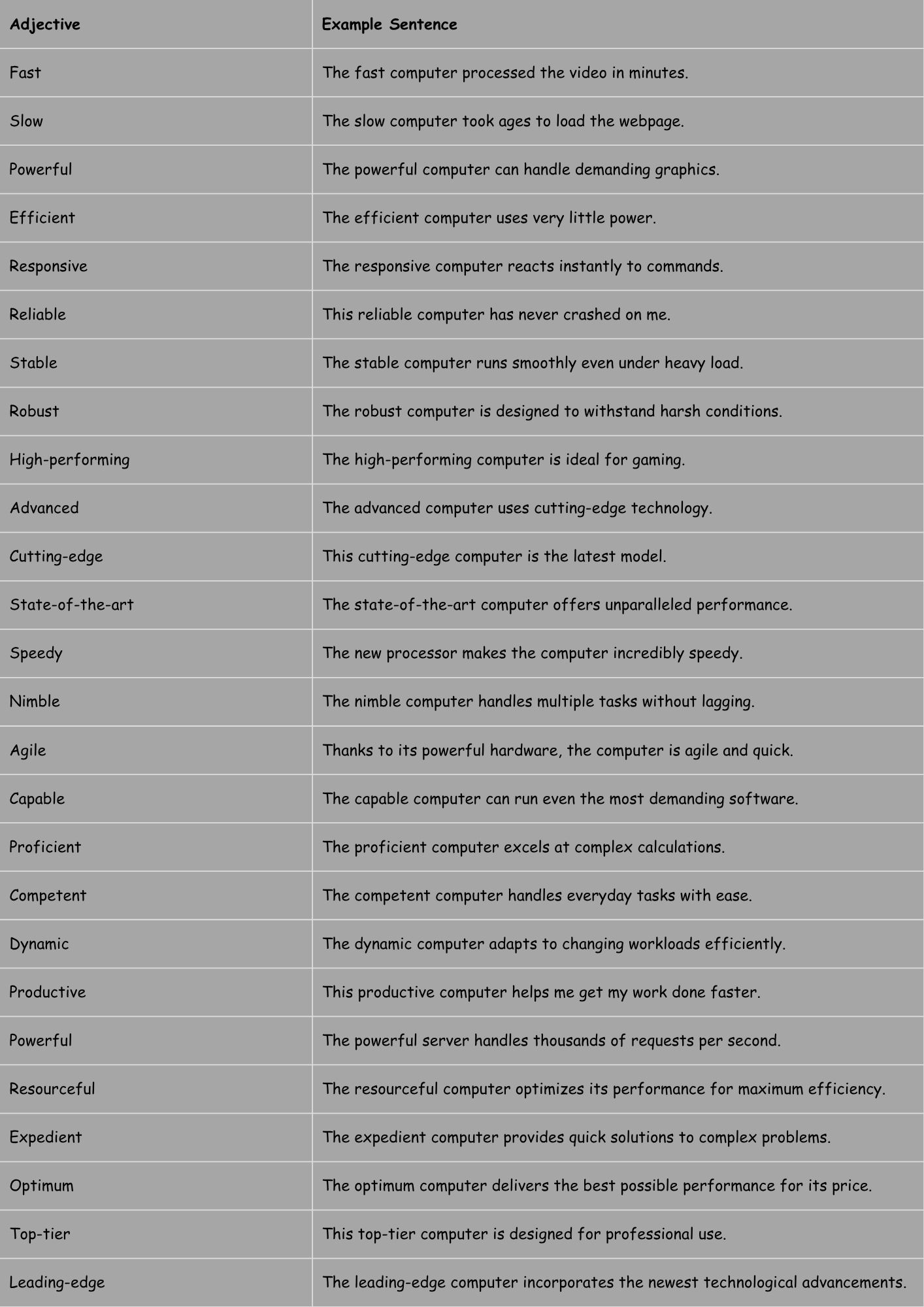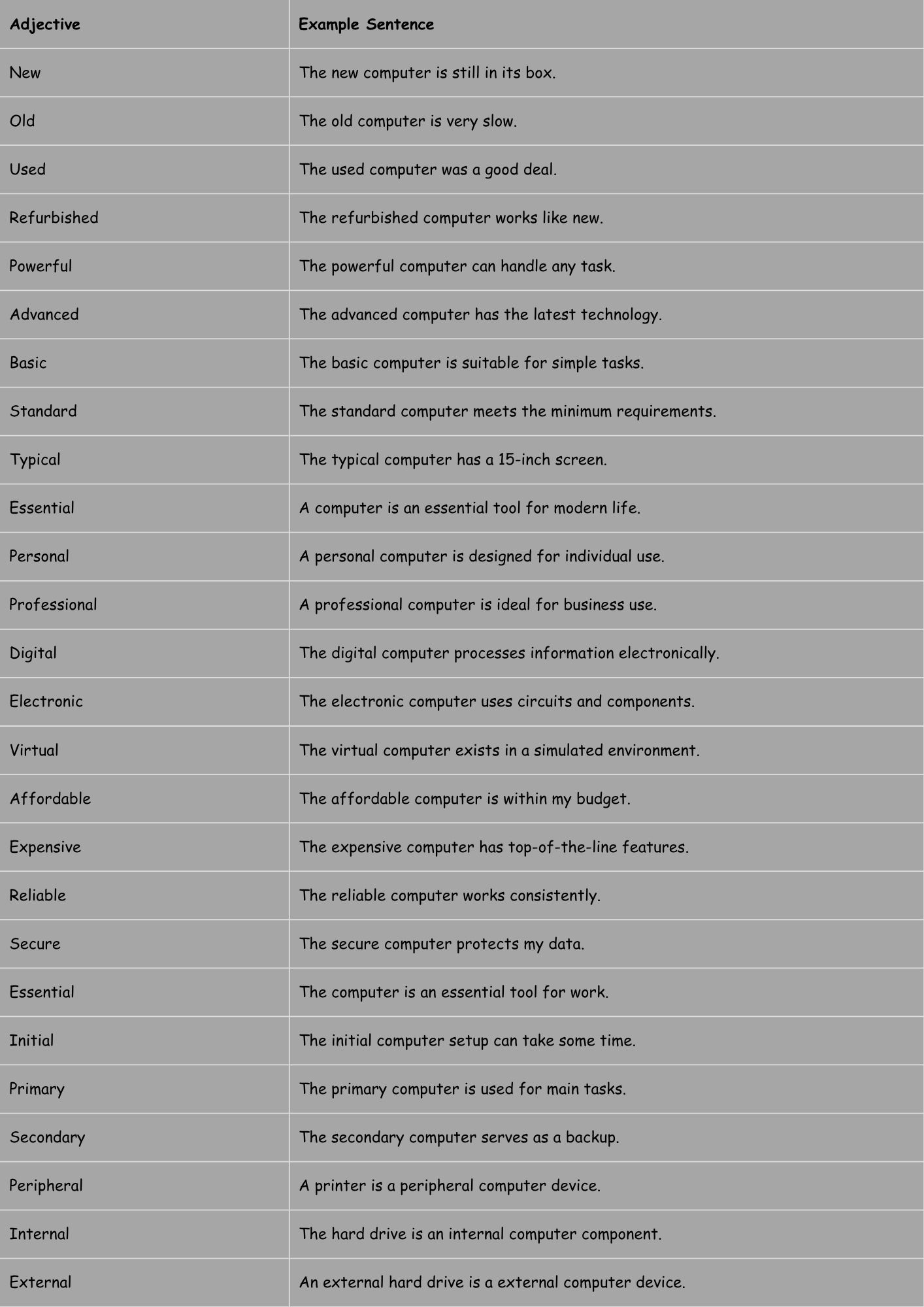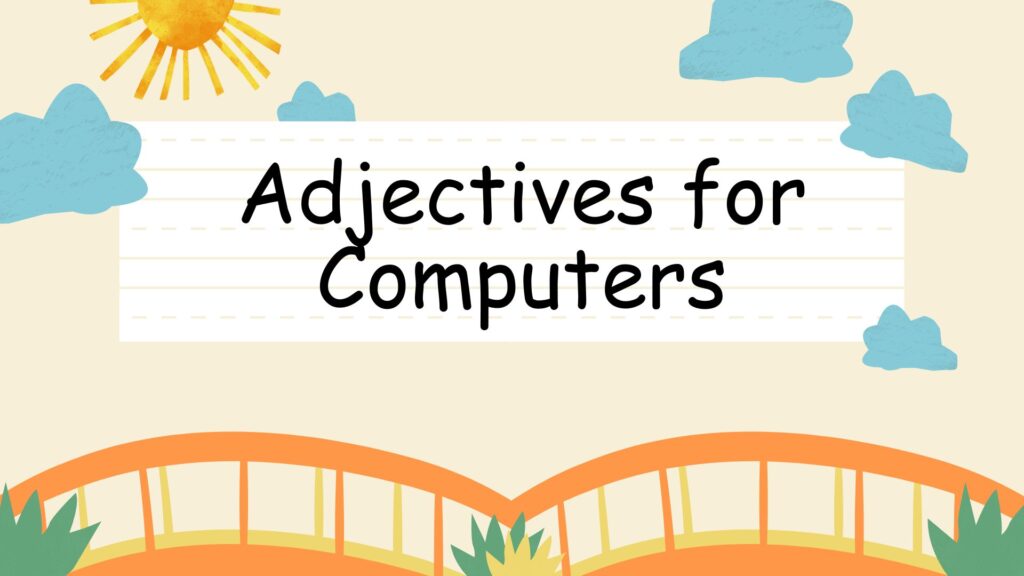In today’s digital age, computers are integral to nearly every aspect of our lives. Whether you’re discussing the latest gaming rig, a sleek laptop, or the powerful servers that run the internet, being able to describe these devices accurately and effectively is crucial. This article delves into the world of adjectives used to describe computers, enhancing your vocabulary and communication skills. It will explore various categories of adjectives, providing numerous examples and practical exercises to help you master the art of describing computers with precision and flair. This guide is beneficial for students, professionals, and anyone seeking to improve their technical communication skills.
Table of Contents
- Introduction
- What are Adjectives for Computers?
- Adjective Placement and Structure
- Types of Adjectives for Computers
- Examples of Adjectives in Use
- Usage Rules for Computer Adjectives
- Common Mistakes and Corrections
- Practice Exercises
- Advanced Topics: Nuances in Adjective Use
- Frequently Asked Questions
- Conclusion
What are Adjectives for Computers?
Adjectives are words that describe or modify nouns. When it comes to computers, adjectives help us provide specific details about their characteristics, capabilities, and appearance. They allow us to differentiate between various types of computers and communicate their features effectively. Adjectives can describe a computer’s performance (fast, efficient), physical attributes (sleek, compact), functionality (versatile, portable), or aesthetic qualities (stylish, modern). Understanding how to use these adjectives correctly is essential for clear and precise communication in the tech world.
The function of adjectives is to add detail and specificity to our descriptions. They answer questions like “What kind?”, “Which one?”, or “How many?” regarding the noun they modify. In the context of computers, adjectives help us paint a more complete picture of the device we’re discussing. This is particularly important when comparing different models, troubleshooting issues, or simply discussing the latest technology with others. The contexts in which you might use adjectives for computers are varied and include technical documentation, marketing materials, user reviews, and everyday conversations.
Adjective Placement and Structure
In English, adjectives typically precede the noun they modify. For example, we say “a powerful computer” rather than “a computer powerful.” However, adjectives can also follow a linking verb (such as is, are, was, were, seems, appears) to describe the subject of the sentence. For instance, “The computer is fast.” The order of adjectives can also matter, especially when using multiple adjectives to describe the same noun.
When using multiple adjectives, there’s a general order to follow: opinion, size, age, shape, color, origin, material, and purpose (OSASCOMP). While this order isn’t always strictly adhered to, it provides a helpful guideline. For example, you might say “a beautiful, large, new, gaming computer.” Here, “beautiful” is an opinion, “large” is size, “new” is age, and “gaming” indicates purpose. Understanding this structure helps ensure your descriptions sound natural and are easily understood. Consider the difference between “a small, old, Japanese laptop” and “an old, small, Japanese laptop.” While both are grammatically correct, the first sounds more natural due to the typical order of adjectives.
Types of Adjectives for Computers
Adjectives for computers can be categorized based on the aspect of the computer they describe. Here are some key categories:
Performance Adjectives
These adjectives describe how well a computer performs its tasks. They focus on speed, efficiency, and overall capability. Examples include fast, slow, powerful, efficient, responsive, reliable, stable, robust, high-performing, advanced, cutting-edge, and state-of-the-art. These adjectives are often used when comparing different computer models or assessing the suitability of a computer for specific tasks.
Physical Characteristic Adjectives
These describe the physical attributes of a computer, such as its size, weight, and appearance. Examples include compact, lightweight, portable, sleek, bulky, thin, large, small, durable, sturdy, robust, and ergonomic. These adjectives are important for describing laptops, tablets, and other portable devices, where size and weight are key considerations. They also help describe the build quality and design of desktop computers and peripherals.
Functional Adjectives
These adjectives describe what a computer can do and its capabilities. Examples include versatile, multi-functional, user-friendly, compatible, programmable, upgradeable, scalable, networkable, interactive, and intuitive. These adjectives are useful for highlighting the features and capabilities of a computer, as well as its ease of use and compatibility with other devices and software.
Aesthetic Adjectives
These describe the appearance and style of a computer. Examples include stylish, modern, elegant, sleek, minimalist, futuristic, attractive, beautiful, aesthetically pleasing, eye-catching, and visually appealing. These adjectives are often used in marketing materials and product reviews to appeal to consumers who value the visual design of their devices. They can also be used to describe custom-built computers with unique designs and modifications.
Descriptive Adjectives
These are general adjectives that provide additional detail about a computer. Examples include new, old, used, refurbished, powerful, advanced, basic, standard, typical, and essential. These adjectives can be used in a variety of contexts to provide a more complete picture of the computer being described. They can also be combined with other types of adjectives to create more nuanced descriptions.
Examples of Adjectives in Use
The following tables provide examples of adjectives used to describe computers, organized by category. Each table includes a variety of adjectives and example sentences to illustrate their usage.
Performance Adjective Examples
This table shows how performance adjectives are used in context to describe a computer’s capabilities.
| Adjective | Example Sentence |
|---|---|
| Fast | The fast computer processed the video in minutes. |
| Slow | The slow computer took ages to load the webpage. |
| Powerful | The powerful computer can handle demanding graphics. |
| Efficient | The efficient computer uses very little power. |
| Responsive | The responsive computer reacts instantly to commands. |
| Reliable | This reliable computer has never crashed on me. |
| Stable | The stable computer runs smoothly even under heavy load. |
| Robust | The robust computer is designed to withstand harsh conditions. |
| High-performing | The high-performing computer is ideal for gaming. |
| Advanced | The advanced computer uses cutting-edge technology. |
| Cutting-edge | This cutting-edge computer is the latest model. |
| State-of-the-art | The state-of-the-art computer offers unparalleled performance. |
| Speedy | The new processor makes the computer incredibly speedy. |
| Nimble | The nimble computer handles multiple tasks without lagging. |
| Agile | Thanks to its powerful hardware, the computer is agile and quick. |
| Capable | The capable computer can run even the most demanding software. |
| Proficient | The proficient computer excels at complex calculations. |
| Competent | The competent computer handles everyday tasks with ease. |
| Dynamic | The dynamic computer adapts to changing workloads efficiently. |
| Productive | This productive computer helps me get my work done faster. |
| Powerful | The powerful server handles thousands of requests per second. |
| Resourceful | The resourceful computer optimizes its performance for maximum efficiency. |
| Expedient | The expedient computer provides quick solutions to complex problems. |
| Optimum | The optimum computer delivers the best possible performance for its price. |
| Top-tier | This top-tier computer is designed for professional use. |
| Leading-edge | The leading-edge computer incorporates the newest technological advancements. |

Physical Characteristic Adjective Examples
This table illustrates adjectives describing the physical appearance and build of computers.
| Adjective | Example Sentence |
|---|---|
| Compact | The compact computer fits easily on my desk. |
| Lightweight | The lightweight computer is perfect for travel. |
| Portable | This portable computer can be taken anywhere. |
| Sleek | The sleek computer has a modern design. |
| Bulky | The bulky computer takes up a lot of space. |
| Thin | The thin computer is very easy to carry around. |
| Large | The large computer has a spacious screen. |
| Small | The small computer is ideal for small offices. |
| Durable | The durable computer can withstand rough handling. |
| Sturdy | The sturdy computer is built to last. |
| Robust | The robust computer can handle harsh environments. |
| Ergonomic | The ergonomic computer is designed for comfortable use. |
| Streamlined | The streamlined computer has a minimalist design. |
| Clunky | The old computer was clunky and difficult to move. |
| Chunky | The chunky computer felt solid and well-built. |
| Slim | The slim computer easily fits into my bag. |
| Wide | The wide computer screen offers more viewing space. |
| Narrow | The narrow computer is designed for small spaces. |
| Solid | The solid computer feels very well-made. |
| Tough | The tough computer is resistant to damage. |
| Elegant | The elegant computer is a beautiful addition to any office. |
| Glossy | The glossy computer finish is prone to fingerprints. |
| Matte | The matte computer finish reduces glare and reflections. |
| Textured | The textured computer surface provides a better grip. |
| Rugged | The rugged computer is designed for outdoor use. |
| Heavy-duty | This heavy-duty computer is built to withstand extreme conditions. |
Functional Adjective Examples
This table provides examples of functional adjectives that describe a computer’s capabilities and ease of use.
| Adjective | Example Sentence |
|---|---|
| Versatile | The versatile computer can be used for many different tasks. |
| Multi-functional | The multi-functional computer combines several features in one device. |
| User-friendly | The user-friendly computer is easy to learn and use. |
| Compatible | The compatible computer works seamlessly with all my devices. |
| Programmable | The programmable computer can be customized to suit your needs. |
| Upgradeable | The upgradeable computer can be improved with new components. |
| Scalable | The scalable computer can grow with your business. |
| Networkable | The networkable computer can easily connect to a network. |
| Interactive | The interactive computer provides a engaging user experience. |
| Intuitive | The intuitive computer is easy to understand and operate. |
| Adaptable | The adaptable computer can adjust to different user preferences. |
| Efficient | The efficient computer optimizes resource usage. |
| Configurable | The configurable computer allows users to customize settings. |
| Automated | The automated computer system streamlines processes. |
| Integrated | The integrated computer combines hardware and software seamlessly. |
| Connected | The connected computer syncs data across devices. |
| Dynamic | The dynamic computer adjusts its settings automatically. |
| Productive | The productive computer helps users accomplish more. |
| Reliable | The reliable computer operates consistently without errors. |
| Secure | The secure computer protects sensitive data. |
| Accessible | The accessible computer is designed for users with disabilities. |
| Advanced | The advanced computer features cutting-edge technology. |
| Collaborative | The collaborative computer facilitates teamwork and communication. |
| Comprehensive | The comprehensive computer offers a wide range of features. |
| Customizable | The customizable computer can be tailored to individual needs. |
| Diagnostic | The diagnostic computer can identify and troubleshoot issues. |
Aesthetic Adjective Examples
This table presents adjectives related to the visual appeal and style of computers.
| Adjective | Example Sentence |
|---|---|
| Stylish | The stylish computer looks great on my desk. |
| Modern | The modern computer has a sleek design. |
| Elegant | The elegant computer is a work of art. |
| Sleek | The sleek computer has a minimalist design. |
| Minimalist | The minimalist computer is clutter-free and simple. |
| Futuristic | The futuristic computer looks like something from a science fiction movie. |
| Attractive | The attractive computer is visually appealing. |
| Beautiful | The beautiful computer is a joy to look at. |
| Aesthetically pleasing | The aesthetically pleasing computer enhances the look of any room. |
| Eye-catching | The eye-catching computer immediately grabs your attention. |
| Visually appealing | The visually appealing computer is designed to impress. |
| Chic | The chic computer is fashionable and trendy. |
| Refined | The refined computer has a sophisticated design. |
| Polished | The polished computer looks sleek and professional. |
| Artistic | The artistic computer is a creative masterpiece. |
| Glamorous | The glamorous computer is flashy and luxurious. |
| Subtle | The subtle computer has an understated elegance. |
| Understated | The understated computer is simple yet stylish. |
| Luxurious | The luxurious computer is made with premium materials. |
| Exquisite | The exquisite computer is crafted with meticulous attention to detail. |
| Classic | The classic computer design never goes out of style. |
| Trendy | The trendy computer is up-to-date with the latest fashions. |
| Fashionable | The fashionable computer is designed to be visually appealing. |
| Impressive | The impressive computer leaves a lasting impression. |
| Alluring | The alluring computer is captivating and enchanting. |
| Captivating | The captivating computer draws you in with its beauty. |
Descriptive Adjective Examples
This table provides general descriptive adjectives that can be used to describe various aspects of computers.
| Adjective | Example Sentence |
|---|---|
| New | The new computer is still in its box. |
| Old | The old computer is very slow. |
| Used | The used computer was a good deal. |
| Refurbished | The refurbished computer works like new. |
| Powerful | The powerful computer can handle any task. |
| Advanced | The advanced computer has the latest technology. |
| Basic | The basic computer is suitable for simple tasks. |
| Standard | The standard computer meets the minimum requirements. |
| Typical | The typical computer has a 15-inch screen. |
| Essential | A computer is an essential tool for modern life. |
| Personal | A personal computer is designed for individual use. |
| Professional | A professional computer is ideal for business use. |
| Digital | The digital computer processes information electronically. |
| Electronic | The electronic computer uses circuits and components. |
| Virtual | The virtual computer exists in a simulated environment. |
| Affordable | The affordable computer is within my budget. |
| Expensive | The expensive computer has top-of-the-line features. |
| Reliable | The reliable computer works consistently. |
| Secure | The secure computer protects my data. |
| Essential | The computer is an essential tool for work. |
| Initial | The initial computer setup can take some time. |
| Primary | The primary computer is used for main tasks. |
| Secondary | The secondary computer serves as a backup. |
| Peripheral | A printer is a peripheral computer device. |
| Internal | The hard drive is an internal computer component. |
| External | An external hard drive is a external computer device. |

Usage Rules for Computer Adjectives
When using adjectives to describe computers, it’s important to follow standard English grammar rules. Adjectives typically come before the noun they modify, but they can also follow a linking verb. Use commas to separate multiple adjectives of equal rank (e.g., “a powerful, efficient computer”). Avoid using too many adjectives in a single phrase, as this can make your writing sound cluttered and awkward.
Be mindful of the order of adjectives. While not a strict rule, following the OSASCOMP order (opinion, size, age, shape, color, origin, material, purpose) can improve the flow and clarity of your writing. Choose adjectives that are appropriate for the context. For example, “gaming” is a suitable adjective for a computer designed for playing video games, but it might not be appropriate for a business laptop. Use precise and specific adjectives to convey your meaning accurately. Instead of saying “a good computer,” try “a reliable computer” or “a fast computer” to provide more specific information.
Common Mistakes and Corrections
One common mistake is using adjectives incorrectly as adverbs. For example, saying “The computer runs good” instead of “The computer runs well.” Another mistake is using the wrong form of an adjective, such as using the comparative form when the superlative is needed (e.g., “This computer is faster” when you mean “This computer is the fastest“).
Overusing adjectives is another frequent error. While adjectives can add detail and specificity, too many can make your writing sound cluttered and confusing. Choose adjectives carefully and use them sparingly. Also, ensure that your adjectives agree with the noun they modify. For example, use “this” or “that” for singular nouns and “these” or “those” for plural nouns. Here are some examples of common mistakes and their corrections:
| Incorrect | Correct | Explanation |
|---|---|---|
| The computer runs good. | The computer runs well. | “Good” is an adjective; “well” is an adverb. |
| This computer is faster than any computer. | This computer is faster than any other computer. | Adding “other” clarifies the comparison. |
| A new, fastly computer. | A new, fast computer. | “Fastly” is not a correct adjective form. |
| The computer is more superior. | The computer is superior. | “Superior” already implies comparison. |
| The most unique computer. | A unique computer. | “Unique” means one-of-a-kind and cannot be graded. |
| The computers are very expensives. | The computers are very expensive. | “Expensive” is an adjective; it doesn’t need an “s.” |
| An user-friendly computer. | A user-friendly computer. | When used as an adjective, user-friendly is hyphenated. |
| The computer is more better than the old one. | The computer is better than the old one. | Avoid using “more” with comparative adjectives. |
| The computer have a fast processor. | The computer has a fast processor. | “Have” is for plural subjects; “has” is for singular. |
| The computers is fast. | The computers are fast. | “Is” is for singular subjects; “are” is for plural. |
Practice Exercises
Test your understanding of adjectives for computers with these practice exercises.
Exercise 1: Choose the best adjective to complete each sentence.
- The _____ computer is perfect for gaming. (powerful / small)
- This _____ laptop is easy to carry around. (lightweight / bulky)
- The _____ computer has a modern design. (sleek / old)
- An _____ computer is essential for modern work. (new / old)
- The _____ computer is easy to learn and use. (user-friendly / complicated)
- The _____ computer handles demanding tasks without lagging. (agile / slow)
- The _____ computer is resistant to damage. (tough / fragile)
- The _____ computer offers a wide range of features. (comprehensive / limited)
- The _____ computer is designed to impress. (visually appealing / dull)
- The _____ computer is within my budget. (affordable / expensive)
Exercise 2: Rewrite the following sentences using more descriptive adjectives.
- The computer is good.
- The laptop is small.
- The computer looks nice.
- The computer is fast.
- The computer is easy to use.
- That computer is old.
- This computer is basic.
- The computer is expensive.
- The computer is reliable.
- The computer is versatile.
Exercise 3: Identify the type of adjective (Performance, Physical, Functional, Aesthetic, Descriptive) used in each sentence.
- The high-performing computer is ideal for video editing.
- The compact computer fits perfectly in my backpack.
- The user-friendly computer is easy for beginners to learn.
- The stylish computer looks great on my desk.
- The new computer has the latest processor.
- The robust computer can withstand harsh conditions.
- The upgradeable computer can be improved with new components.
- The minimalist computer is clutter-free and simple.
- The used computer was a good deal.
- The scalable computer can grow with your business.
Answers for Exercise 1:
- powerful
- lightweight
- sleek
- new
- user-friendly
- agile
- tough
- comprehensive
- visually appealing
- affordable
Example Answers for Exercise 2: (Note: Multiple answers are possible)
- The reliable and efficient computer is a great investment.
- The lightweight and portable laptop is perfect for travel.
- The computer looks modern and sleek.
- The computer is incredibly fast and responsive.
- The computer is intuitive and user-friendly.
- That computer is old and slow.
- This computer is basic and affordable.
- The computer is expensive and powerful.
- The computer is reliable and stable.
- The computer is versatile and multi-functional.
Answers for Exercise 3:
- Performance
- Physical
- Functional
- Aesthetic
- Descriptive
- Performance
- Functional
- Aesthetic
- Descriptive
- Functional
Advanced Topics: Nuances in Adjective Use
For advanced learners, understanding the nuances of adjective use can significantly enhance your writing and communication skills. This involves recognizing subtle differences in meaning between similar adjectives, understanding the connotations of certain adjectives, and using adjectives creatively to create vivid and engaging descriptions.
For example, consider the difference between “efficient” and “effective.” While both adjectives describe positive qualities, “efficient” implies that something is done with minimal waste of resources, while “effective” implies that something achieves the desired result. Choosing the right adjective depends on the specific context and the aspect of the computer you want to emphasize.
Another advanced topic is the use of figurative language, such as metaphors and similes, to describe computers. This can involve using adjectives in unexpected or unconventional ways to create a more vivid and memorable impression. For example, you might describe a computer as “a digital fortress” to emphasize its security features, or as “a lightning-fast processor” to highlight its speed. Mastering these advanced techniques can help you communicate more effectively and persuasively in a variety of contexts.
Frequently Asked Questions
- What is the correct order of adjectives when describing a computer?The general order is opinion, size, age, shape, color, origin, material, and purpose (OSASCOMP). For example: “a beautiful, small, new, Japanese laptop.”
- Can I use too many adjectives in a sentence?Yes, overusing adjectives can make your writing sound cluttered and awkward. Choose adjectives carefully and use them sparingly.
- What’s the difference between “efficient” and “effective” when describing a computer?“Efficient” implies using minimal resources, while “effective” means achieving the desired result. A computer can be efficient in its power usage or effective in completing complex tasks.
- How can I improve my vocabulary of adjectives for computers?Read technical articles, product reviews, and marketing materials to expose yourself to a wide range of adjectives used in the context of computers. Practice using new adjectives in your own writing and speaking.
- Are there any adjectives that should be avoided when describing computers?Avoid using vague or subjective adjectives that don’t provide specific information. Also, avoid using overly technical or jargonistic adjectives that may not be understood by a general audience.
- What are some good adjectives to describe a computer’s security?Secure, protected, encrypted, fortified, robust, and resilient are all good adjectives to describe a computer’s security features.
- How do I choose the right adjective to describe a computer’s performance?Consider the specific aspect of performance you want to emphasize. Use “fast” or “speedy” to describe processing speed, “powerful” to describe overall capability, and “efficient” to describe resource usage.
- Can adjectives be used to compare two computers?Yes, you can use comparative and superlative forms of adjectives to compare computers. For example: “This computer is faster than that one,” or “This computer is the fastest on the market.”
Conclusion
Mastering the use of adjectives to describe computers is essential for effective communication in today’s technology-driven world. By understanding the different types of adjectives, following usage rules, and avoiding common mistakes, you can
enhance your ability to articulate the nuances and characteristics of various computing devices. Whether you’re a student, a professional, or simply a tech enthusiast, the skills and knowledge gained from this guide will undoubtedly improve your technical vocabulary and communication skills. Keep practicing and refining your use of adjectives, and you’ll become a more confident and effective communicator in the digital age.



